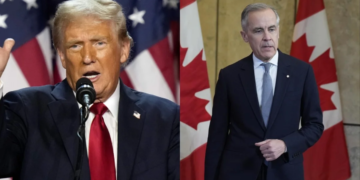Concluding Donald Trump’s highly anticipated Congress address on ‘Liberation Day ‘, the 47th POTUS confirmed that reciprocal tariffs will be levied on all of America’s trading partners from April 2nd, 2025. Despite being a tough sell, especially among their Western peers, American economists are employing a tough yet familiar marketing strategy. Infamous for his geopolitical ‘knock for six’, Trump aims at imploding tariffs on automobile parts and machinery, while forwarding his territorial nuances for Greenland and the Panama Canal. So what is Trump’s April 2 tariff plan?
Trump’s Trade War With China
The initiation of the trade war with China began with a recent 10% tariff on $400 billion in a mass of Chinese products and services exported each year to the US in February 10%. This later culminated in an additional 10% tariff on March 4, providing business strategists around the globe with a market-distorting assortment of financial conceptions.
Brooklyn-based founder and CEO of Citibin, Liz Picarazzi mentioned that most of her imports, which will now practice 50% tariffs, were Chinese, and aren’t feasible for manufacturing in the US. She, among many others, exclaims the poorly sustainable concept of encouraging native manufacturing through Tariffs.
Despite refusing to comment on the issue, Walmart and Costco, the two major Wholesale providers, stay committed to their statement of working closely with the state during these uncertain times. While other small retailers have chosen to replace bases and revamp their manufacturing hubs in Vietnam.
Stanford University however assures a restructuring effect of up to 0.35% fall, on the imposition of a 1% tariff on the Chinese. However, not surprisingly some Chinese professors also discussed countermeasures including requiting tariffs on the US, and focusing on increasing domestic consumption, which has been quasi-stagnant since the impact of COVID-19 had retired.
Primarily catapulting the financial trends and brokerage of the developing world, particularly towards the downward trends, the aforementioned tariffs may have a considerable effect on electrical machinery, the smartphone industry, ornament imports, especially precious jewels, pharmaceuticals, and automatic parts.
ALSO READ: India-US Tariff Situation: Negotiation and Strategy
April 2 Tariff Plan: Impact on Allies and Friends

Among the US’s close associates, Japan expressed its worries concerning the export restrictions the auto industry is about to concur following the tariff imposition. During his interview with Takahide Kiuchi, an economist from the University of Nomura mentioned that 25% tariffs will shrink the economy of Japan by 0.2%, which is alarming considering the almost stagnant and aging era of Japanese GDP. PM of Japan, Shigeru Ishiba, conferenced ‘appropriate response’ for the US imports, warning ‘everything is on the table’.
Europe and Canada, however, responded more stringently to the forthcoming announcement on April 2nd, EU Commission reiterated their discomfort regarding US tariff on EU steel and aluminum imports adding to the disharmony looming in the EU- US relationship that was initiated with the “leaked chats for Houthi issue” debacle, adding to the list of fiascos of the newly elected America Administration.
Concerning the Middle East, the potential introduction of general global tariffs is supposedly going to earmark minimal hindrance for their Aluminium and steel imports, least concerning military Allies like Israel and Jordan.
India has the task to initiate previously frozen Indo-US trade deal. This might assure some relief for the largest democracy, whose major foreign direct investment and balance of trade favors the Indians. However, uncertainty will likely arise regarding their Pharmaceutical sector and their recently solidifying defense exports.
Impact on Russia, Vietnam, Africa, And Mexico
With the newly established quasi-cordial relationship with Russia, analysts emphasize the recently mentioned oil tariff threat. This will likely destabilize the crude oil barrel rates throughout the globe, despite being still ousted from the SWIFT payment system, following the Ukrainian invasion.
Vietnam might potentially see a wide range of disruption in its export-based economy and job losses. The possibility of starting a global trade conflict will likely not work. This prompts Vietnamese companies to rejuvenate newer techniques to improve product quality.
Mexico however might plunge into a recession, partnering with Canada for a similar fate. Associated concerns have already begun to traumatize the auto export of companies like Ford, whose most of the factories are set up in this South American nation. Aiming to explore more markets for their exports Canadian analysts have chained multiple meets to collaborate with the EU.
Re-routing multiple economies, such financial manipulations by major economies often unify to impact pockets of the common civilians, and are practically unsustainable for the global economy, shrinking it to about 0.5% by the end of 2026.
How do you think Trump’s April 2 tariff plan will affect the economy? Subscribe to TheWhatIs and let’s discuss about the world economy!















Discussion about this post